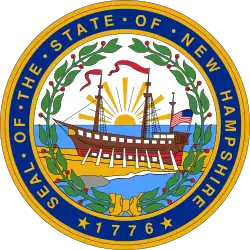William Badger
William Badger (January 13, 1779 – September 21, 1852) was an American manufacturer and mill owner from Gilmanton, New Hampshire. He served in both houses of the New Hampshire state legislature and was elected Governor of New Hampshire for two terms.
William Badger | |
|---|---|
 | |
| 15th Governor of New Hampshire | |
| In office June 5, 1834 – June 2, 1836 | |
| Preceded by | Samuel Dinsmoor |
| Succeeded by | Isaac Hill |
| President of the New Hampshire Senate | |
| In office 1816–1817 | |
| Preceded by | Moses P. Payson |
| Succeeded by | Jonathan Harvey |
| Member of the New Hampshire Senate | |
| In office 1814–1817 | |
| Member of the New Hampshire House of Representatives | |
| In office 1810–1812 | |
| Personal details | |
| Born | January 13, 1779 Gilmanton, New Hampshire |
| Died | September 21, 1852 (aged 73) Gilmanton, New Hampshire |
Biography
Badger was born in Gilmanton, New Hampshire.[1] Educated at common school and at Gilmanton Academy, Badger worked after his school years to build a cotton cloth factory, a saw mill and a grist mill for his town. In 1804 Badger was made a trustee of Gilmanton Academy; he ultimately became president of the board for the school.
Badger served as an aide to John Langdon (Governor four different times, including 1805 to 1809). In 1810, Badger was elected to the first of three consecutive terms as a member of the New Hampshire House of Representatives (1810–1812); then he served three terms in the New Hampshire Senate (1814–1817) where he served as President of the Senate in 1816–1817. Badger served as Associate Justice, Court of Common Pleas (1816–1820), and as High Sheriff of Strafford County, New Hampshire (1820–1830). He was a Presidential Elector in the national elections of 1824, 1836 and 1844.
In 1834, Badger won the gubernatorial election, and he won the next term as well. As Governor, Badger called for eliminating capital punishment, a new idea for New Hampshire. He also had to deal with the breakaway Indian Stream Republic. Badger encouraged the legislature to support President Andrew Jackson's successful efforts to do away with the Second Bank of the United States (helping to bring on the Panic of 1837). Badger tried to inject new life into the state militia by statute; he also was interested in bringing smallpox prevention directly to the state's small farming towns.
See also
- New Hampshire Historical Marker No. 235: Belmont Mill / Saving the Belmont Mill
References
- "A Guide to Likenesses of New Hampshire Officials and Governors on Public Display at the Legislative Office Building and the State House Concord, New Hampshire, to 1998". New Hampshire Division of Historical Resources. Retrieved April 10, 2016.
Additional Information on William Badger from: Publications – A Guide to Likenesses of New Hampshire Officials and Governors on Public Display at the Legislative Office Building and the State House Concord, New Hampshire, to 1998 Compiled by Russell Bastedo, New Hampshire State Curator, 1998
| Party political offices | ||
|---|---|---|
| Preceded by Samuel Dinsmoor |
Democratic nominee for Governor of New Hampshire 1834, 1835 |
Succeeded by Isaac Hill |
| Political offices | ||
| Preceded by Samuel Dinsmoor |
Governor of New Hampshire 1834–1836 |
Succeeded by Isaac Hill |
| Preceded by Moses P. Payson |
President of the New Hampshire Senate 1816–1817 |
Succeeded by Jonathan Harvey |
